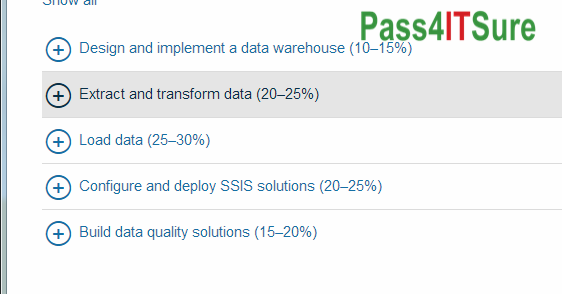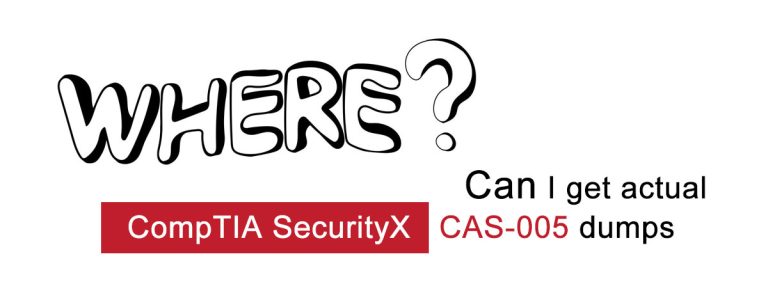Microsoft Exam 070-464 dumps which study guides are better? “Developing Microsoft SQL Server 2012 Databases” also known as 70-464 exam, is a Microsoft certification which covers all the knowledge points of the real Microsoft exam.100% real Microsoft 70-464 dumps exam Microsoft Data Platform certification training will be more popular. Pass4itsure Microsoft 70-464 dumps exam questions answers are updated (182 Q&As) are verified by experts.
The associated certifications of 70-464 dumps is Microsoft Data Platform. Pass4itsure has been to make the greatest efforts to provide the best and most convenient service for our candidates. High speed and high efficiency are certainly the most important points. In today’s society, high efficienct https://www.pass4itsure.com/70-464.html dumps is hot topic everywhere.
Exam Code: 70-464
Exam Name: Developing Microsoft SQL Server 2012 Databases
Q&As: 182
[New Other Microsoft 70-461 Dumps Release From Google Drive]: https://drive.google.com/open?id=0BwxjZr-ZDwwWRFNLVl8xNFJPejg
[New Other Microsoft 70-347 Dumps Release From Google Drive]: https://drive.google.com/open?id=0BwxjZr-ZDwwWdkVZWTJKYnNWUzA
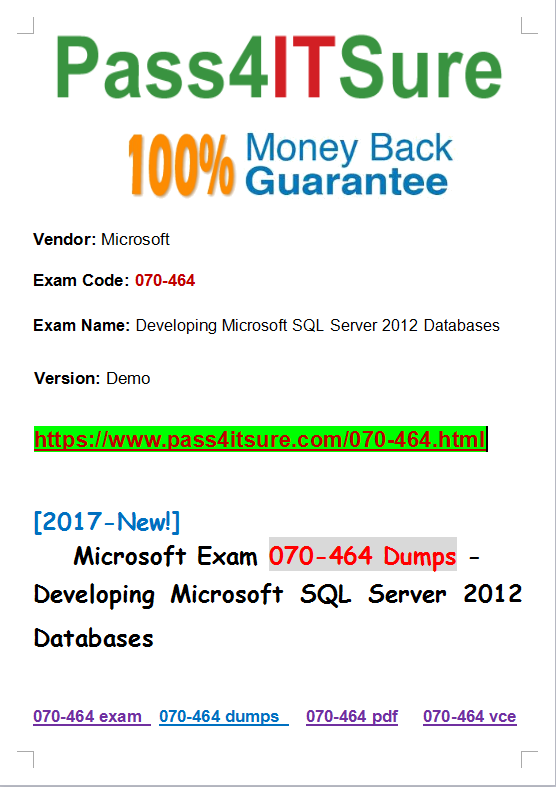
Pass4itsure Microsoft 70-464 Dumps Training Program Online Here:
QUESTION 6
You need to modify the stored procedure usp_LookupConcurrentUsers. What should you do?
A. Use the summary table as an in-memory optimized table with a non-hash clustered index.
B. Use the summary table as an in-memory optimized table with a non-hash nonclustered index.
C. Use a type variable instead of the summary table.
D. Add a clustered index to the summary table.
070-464 exam Correct Answer: A
Explanation
Explanation/Reference:
QUESTION 7
You need to design the user activity table. Which three steps should you perform in sequence? To answer, move the appropriate three actions from the list of actions to the answer area and arrange them in the correct order.
Select and Place:
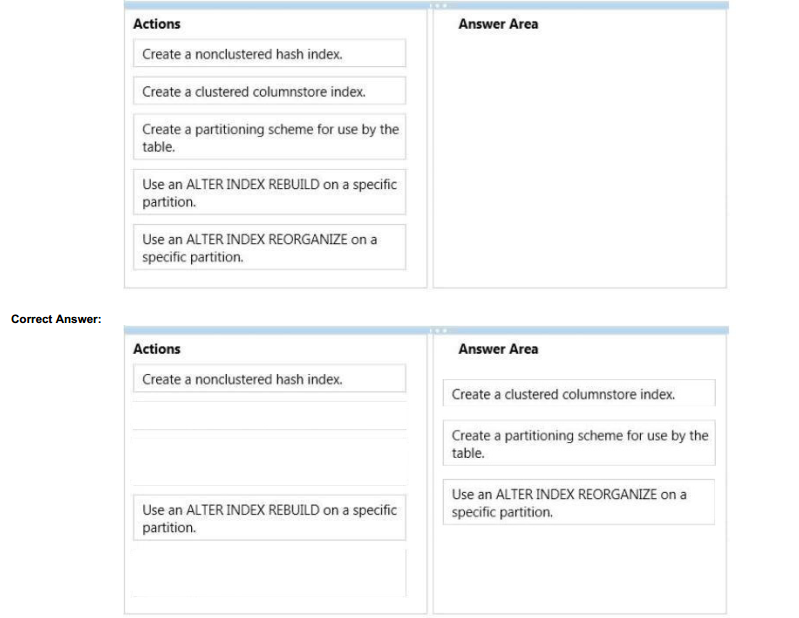
Explanation
Explanation/Reference:
Note:
Creating a partitioned table or index typically happens in four parts:
1. Create a filegroup or filegroups and corresponding files that will hold the partitions specified by the partition scheme.
2. Create a partition function that maps the rows of a table or index into partitions based on the values of a specified column.
3. Create a partition scheme that maps the partitions of a partitioned table or index to the new filegroups.
4. Create or modify a table or index and specify the partition scheme as the storage location.
* Reorganizing an index uses minimal system resources.
* From scenario:
/ The index maintenance strategy for the user activity table must provide the optimal structure for both maintainability and query performance.
/ The CoffeeAnalytics database will combine imports of the POSTransaction and MobileLocation tables to create a user activity table for reports on the trends inactivity. Queries against the UserActivity table will include aggregated calculations on all columns that are not used in filters or groupings.
/ When the daily maintenance finishes, micropayments that are one week old must be available for queries in the UserActivity table but will be queried most frequently within their first week and will require support for in-memory queries for data within the first week. The maintenance of the UserActivity table must allow frequent maintenance on the day’s most recent activities with minimal impact on the use of disk space and the resources available to queries. The processes that add data to the UserActivity table must be able to update data from any time period, even while maintenance is running.
* Columnstore indexes work well for mostly read-only queries that perform analysis on large data sets. Often, these are queries for data warehousing workloads. Columnstore indexes give high-performance gains for queries that use full table scans and are not well-suited for queries that seek into the data, searching for a particular value.
QUESTION 8
You need to create the user.AssignUser stored procedure. Develop the solution by selecting and arranging the required code blocks in the correct order.
You may not need all of the code blocks.
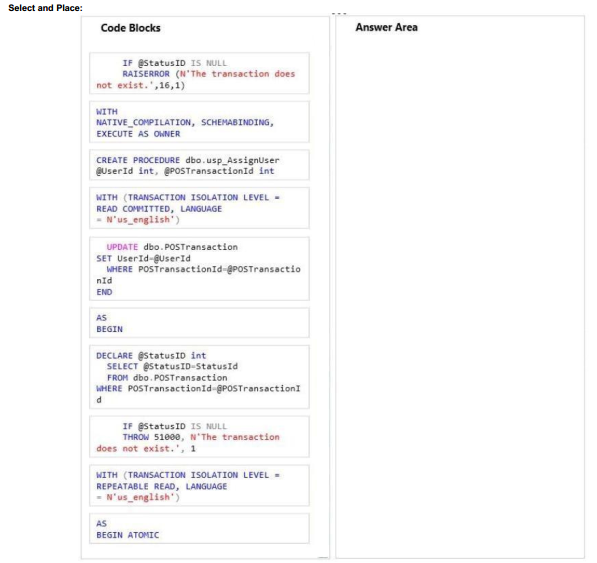
70-464 dumps Correct Answer:
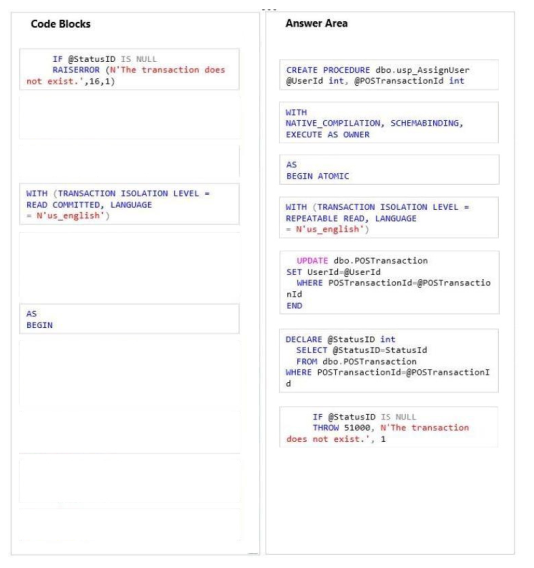
Explanation
Explanation/Reference:
Note:
* From scenario: The mobile application will need to meet the following requirements:
/Communicate with web services that assign a new user to a micropayment by using a stored procedure named usp_AssignUser.
* Example: create procedure dbo.OrderInsert(@OrdNo integer, @CustCode nvarchar(5)) with native_compilation, schemabinding, execute as owner as
begin atomic with (transaction isolation level = snapshot, language = N’English’) declare @OrdDate datetime = getdate(); insert into dbo.Ord (OrdNo, CustCode, OrdDate) values (@OrdNo, @CustCode, @OrdDate);
* Natively compiled stored procedures are Transact-SQL stored procedures compiled to native code that access memory-optimized tables. Natively compiled
stored procedures allow for efficient execution of the queries and business logic in the stored procedure.
* READ COMITTED versus REPEATABLE READ
Read committed is an isolation level that guarantees that any data read was committed at the moment is read. It simply restricts the reader from seeing any
intermediate, uncommitted, ‘dirty’ read. IT makes no promise whatsoever that if the transaction re-issues the read, will find the Same data, data is free to change after it was read. Repeatable read is a higher isolation level, that in addition to the guarantees of the read committed level, it also guarantees that any data read cannot change, if the transaction reads the same data again, it will find the previously read data in place, unchanged, and available to read.
* Both RAISERROR and THROW statements are used to raise an error in Sql Server. The journey of RAISERROR started from Sql Server 7.0, where as the journey of THROW statement has just began with Sql Server 2012. obviously, Microsoft suggesting us to start using THROW statement instead of RAISERROR. THROW statement seems to be simple and easy to use than RAISERROR.
* Explicit transactions. The user starts the transaction through an explicit BEGIN TRAN or BEGIN ATOMIC. The transaction is completed following the
corresponding COMMIT and ROLLBACK or END (in the case of an atomic block).
QUESTION 9
You need to implement a new version of usp_AddMobileLocation. Develop the solution by selecting and arranging the required code blocks in the correct order. You may not need all of the code blocks.
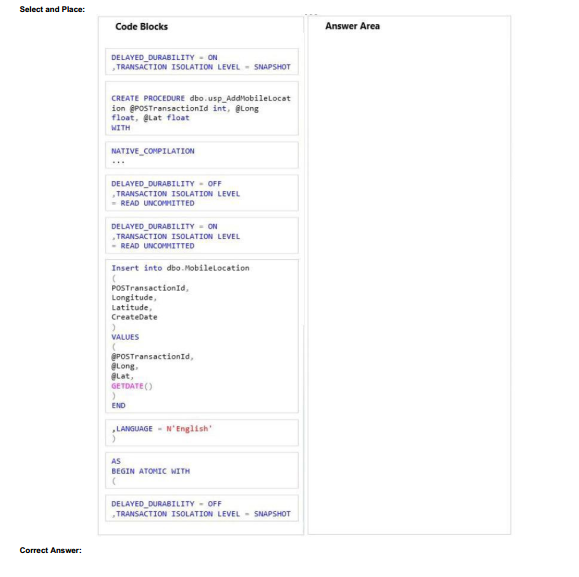
Explanation
Explanation/Reference:
Note:
* From scenario:
The mobile application will need to meet the following requirements:
· Update the location of the user by using a stored procedure named usp_AddMobileLocation.
* DELAYED_DURABILITY
SQL Server transaction commits can be either fully durable, the SQL Server default, or delayed durable (also known as lazy commit).
Fully durable transaction commits are synchronous and report a commit as successful and return control to the client only after the log records for the transaction are written to disk. Delayed durable transaction commits are asynchronous and report a commit as successful before the log records for the transaction are written to disk. Writing the transaction log entries to disk is required for a transaction to be durable. Delayed durable transactions become durable when the transaction log entries are flushed to disk.
QUESTION 10
You need to redesign the system to meet the scalability requirements of the application. Develop the solution by selecting and arranging the required code blocks in the correct order. You may not need all of the code blocks.
Select and Place:
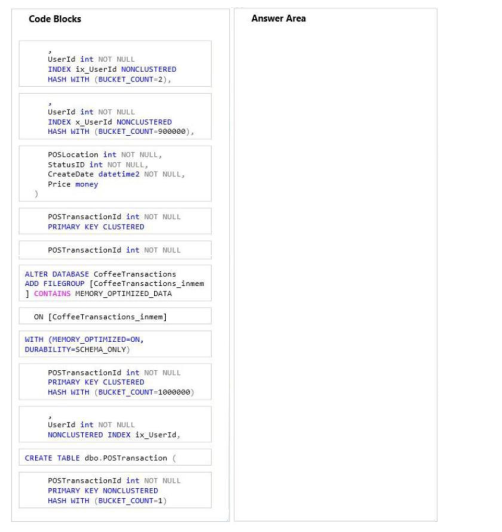
070-464 pdf Correct Answer:
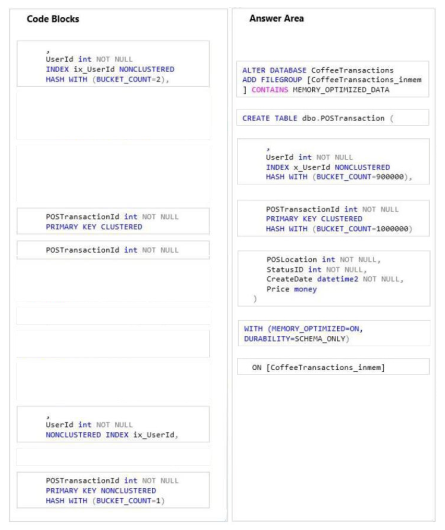
Explanation
Explanation/Reference:
Note:
* MEMORY_OPTIMIZED_DATA
First create a memory-optimized data filegroup and add a container to the filegroup. Then create a memory-optimized table.
* You must specify a value for the BUCKET_COUNT parameter when you create the memory- optimized table. In most cases the bucket count should be between
1 and 2 times the number of distinct values in the index key.
* Example:
— create a durable (data will be persisted) memory-optimized table — two of the columns are indexed
CREATE TABLE dbo.ShoppingCart (
ShoppingCartId INT IDENTITY(1,1) PRIMARY KEY NONCLUSTERED, UserId INT NOT NULL INDEX ix_UserId NONCLUSTERED HASH WITH
(BUCKET_COUNT=1000000),
CreatedDate DATETIME2 NOT NULL,
TotalPrice MONEY
) WITH (MEMORY_OPTIMIZED=ON)
GO
QUESTION 11
You need to optimize the index and table structures for POSTransaction. Which task should you use with each maintenance step? To answer, drag the appropriate tasks to the correct maintenance steps. Each task may be used once, more than once, or not at all. You may need to drag the split bar between panes or scroll to view content.
Select and Place:
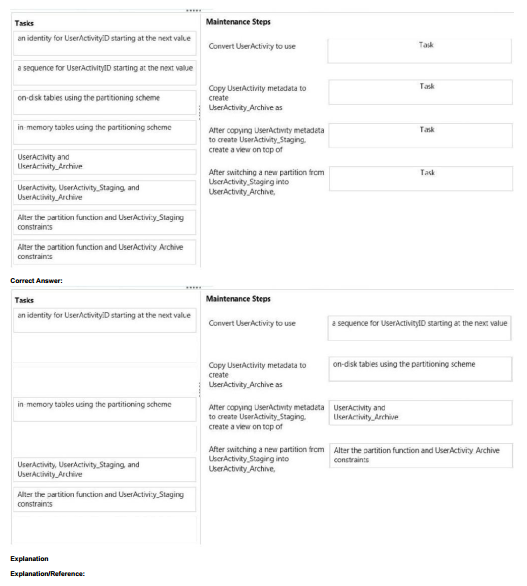
So we designed 70-464 dumps training materials which have hign efficiency for the majority of candidates. It allows candidates to grasp the knowledge quickly, and achieved excellent results in the exam. Pass4itsure’s Microsoft https://www.pass4itsure.com/70-464.html dumps exam training materials can help you to save a lot of time and effort. You can also use the extra time and effort to earn more money.


